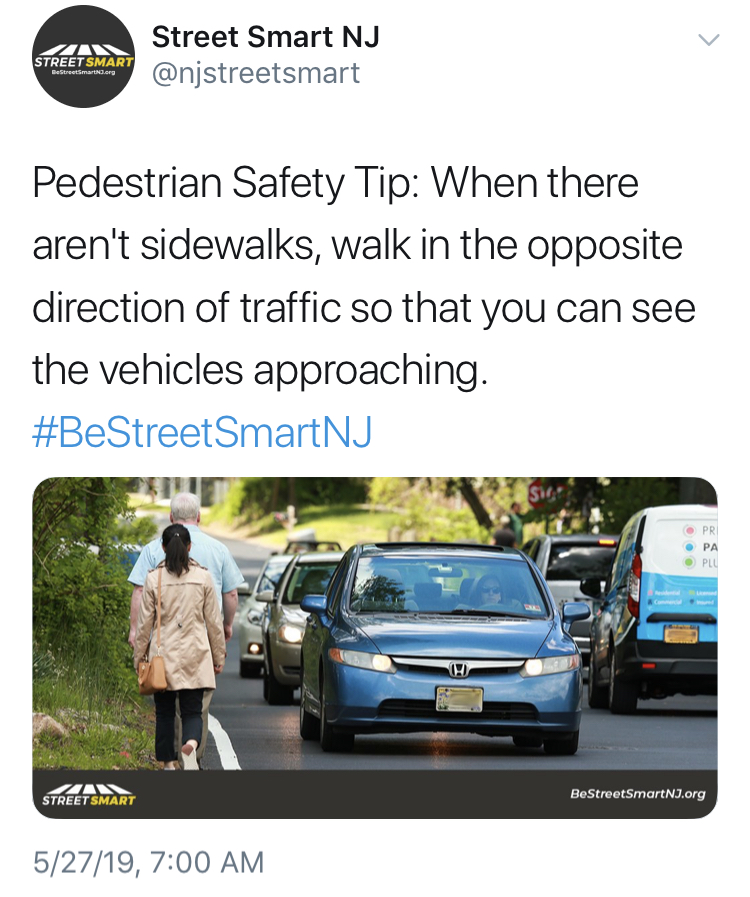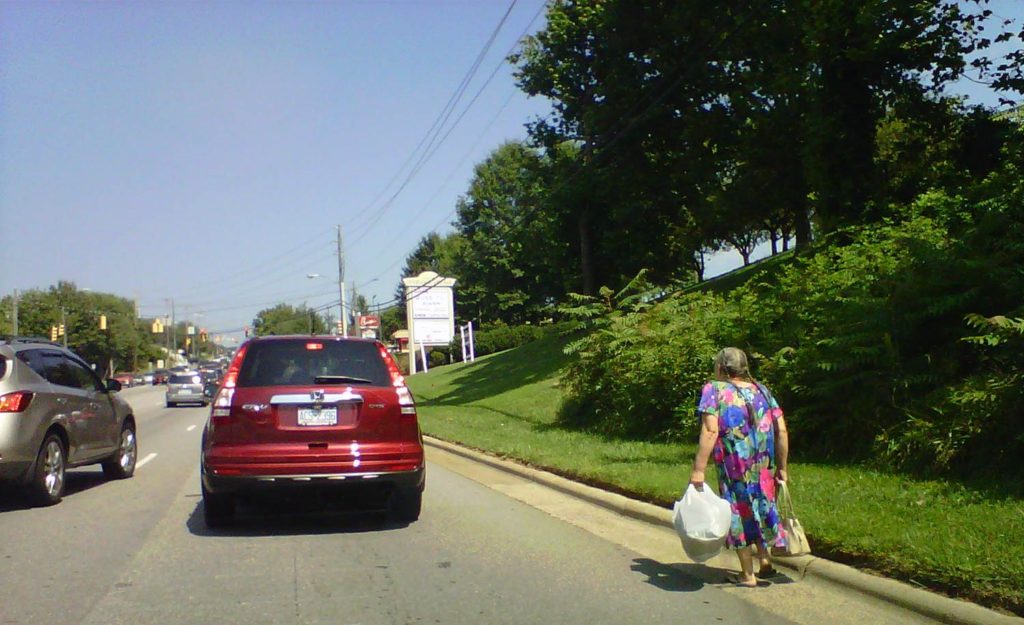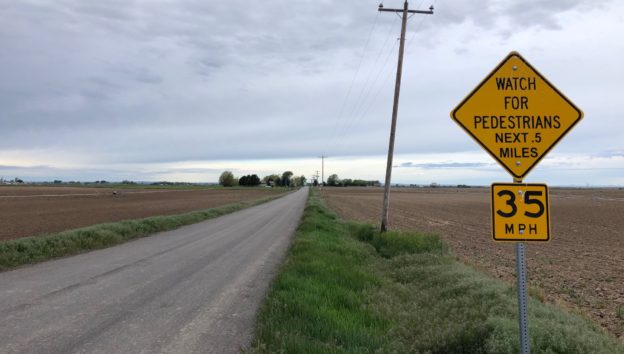by Don Kostelec
May 31, 2019
“Pedestrians, always walk facing traffic when there aren’t sidewalks.”
– The friendly folks sitting in a cubicle at your local or state transportation department
We see this refrain repeated ad nauseum by traffic safety organizations, many of them housed within state DOTs. It’s a tell-tale sign that the agency issuing this tip is detached from the reality of the situation on their own streets.
The “walk facing traffic” mantra is embedded in many state laws and city ordinances. The reality is this law was never intended for urban areas, much less the high-speed, multi-lane arterials that were purposely engineered without sidewalks by many of these same state DOTs.
Think about urban streets and rural roadways in the early 1900s. Before modern street design standards and zoning ordinances, the nearly-universal street design practice in cities was to have sidewalks on both sides of a street. Most people walked to their destinations, with longer-distance travel reserved for horses, trains, streetcars, and the emerging automobile.

Where would you find roadways without sidewalks in the 1920s? You’d find them along rural, two-lane roads on the fringe, developing areas of cities or well beyond city limits.
The requirement to walk facing traffic made sense on these rural roadways, which is why the law exists. Traffic volumes were light and nothing was more than two lanes wide. This made it easy to find a gap in traffic and cross to the other side to walk facing traffic in an area, especially in these areas pedestrians weren’t as common.
The lawmakers of the early 1900s, even as motordom was taking hold of our streets, could not fathom a roadway built within a city that lacked sidewalks on both sides. They also couldn’t fathom an urban corridor development pattern with block lengths that are several thousand feet long. Even in rural areas, they couldn’t imagine making the same request of a pedestrian to walk facing traffic along a four-lane highway that’s divided by a grass median more than a mile long. How could they cross the route to get there?
Average motor vehicle speeds were low in the early 1900s, so even when more traffic was present, the prospects of crossing a street that lacked sidewalks was not as daunting as it is on today’s 40 mph, five-lane, 30,000 vehicles per day arterials, with a 2,000 foot distance between controlled crossings.
Further, the lawmakers of that time could not fathom that major urban thoroughfares would suffer from decades of policy neglect, especially by state DOTs, who built roads wide, fast roads through cities without ever considering the needs of people outside of motor vehicles. The policymakers couldn’t fathom agencies like this would out-source the safety of pedestrians to cities by telling cities to pay for sidewalks if they want them.
The image below is one I caught on US 74-A (South Tunnel Road) when I lived in Asheville, NC. Think about the situation this woman is placed in when it comes to obeying the so-called “pedestrian safety laws.” She’s just trying to get from a nearby store to the bus stop that’s located up ahead on the right at the next traffic signal.

She would be blamed for her own death if a motorist hit and killed her because she is walking with the flow of traffic. The crash report, along with corresponding media reports, would cite her position on the roadway and the story would likely include some helpful tip: “We always want pedestrians to walk facing traffic. It’s the law!,” said Traffic Safety Sergeant Ben Viktimblaymer. Another death due to the pedestrian’s error. Traffic was moving again within 30 minutes.
Neither the media nor the police would consider that she’s forced to break the law no matter what she does because of how the engineers—NCDOT in this case—designed the road.
There are 1,100-ft gaps between legal crossings of the road and it has 16,000 vehicles per day. It is posted for 35 mph. What is she expected to do in those conditions?
If she wants to get to the other side of the road to walk facing traffic, she has to wait for a gap in four lanes of traffic, as well as a center turn lane. At 35 mph, that would mean four full lanes would have to be clear for a distance of 1,200 feet in all directions for motorists to not be a threat to her if she crosses at a pace of 3 feet per second.
If she was hit in that scenario, she’d also be blamed for breaking the law by failing to cross at a crosswalk. To be within the law, she’d have to get to the intersection you see ahead and then cross back over the same road—at a signal that lacks crosswalks, pedestrian signals, or a receiving curb ramp, and is engineered so she has two directions of turning traffic across her path.
Given her physical condition, this expectation is unrealistic. What other option does she have? The one she chose: To walk in the gutter pan with the flow of traffic.
The choice she made was forced upon her by the engineers of the road who, knowingly or not, designed a corridor with no regard for what state laws ask of pedestrians in the situation they designed.
No matter the path a pedestrian chooses in this situation, they are forced to break the law and would be blamed for their death like so many have.
How do we rectify the disconnect between the law and road design?
A first step would be to redefine the law to make the walk facing traffic requirement apply only to rural, two-lane roadways, and local, residential streets within cities that lack sidewalks.
There should be no expectation to walk facing traffic on any collector or arterial in an urban area, or along multi-lane streets in rural and urban areas. The roads aren’t engineered to make that a valid expectation for someone on foot. They are disconnected from the laws.
The next step would be aligning engineering standards for sidewalk and safe crossings with the reality of a pedestrian. They can’t be expected to have gaps longer than a few hundred feet in order to cross a road, so says the national organizations of state DOTs, aka AASHTO. Sidewalks are required on both sides of any roadway within an urban area, as defined by the US Census, and that aligns with prevailing FHWA guidance.
We won’t get that, of course, because it’s much more convenient for the traffic safety organizations to issue their safety tips from the safety of their cubicle than to align their messaging to be consistent with their agency’s practices.

